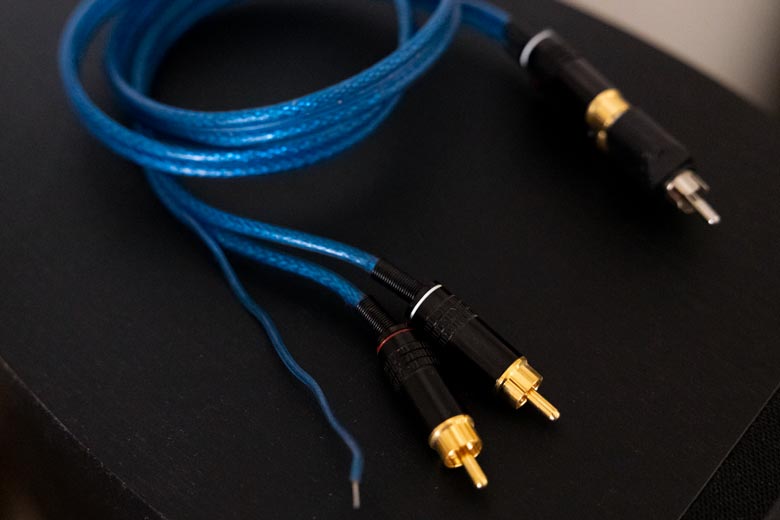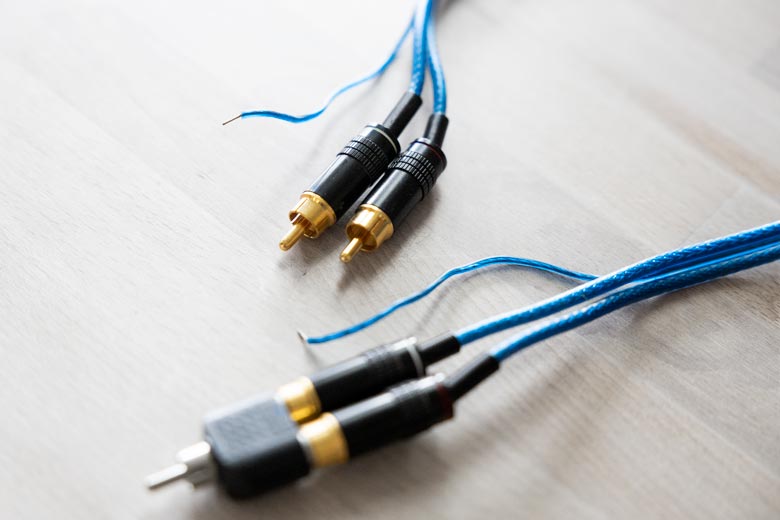So there you are, looking to buy new cables for your subwoofer, and you see some of them are labeled directional. But, of course, they are more expensive. But can subwoofer cables even be directional, and would directional cables make a difference?
Subwoofer cables are not directional. Your subwoofer runs off alternating current, and current only flows in one direction in direct current systems, such as batteries. Hence, the directionality of a subwoofer cable doesn’t matter.
Understanding speaker cables and their complexity is essential for getting the finest sound out of your system. Speaker wires are more complicated than you may think, so continue reading as I explore everything you need to know about subwoofer cables.

Are Subwoofer Cables Different From RCA?
Subwoofer cables are different from RCA because they have thicker shielding. The thick shielding ensures static noise isn’t picked up as the signal travels from the audio source to the speaker.
A subwoofer cable is designed to capture the low-frequency signals coming from the receiver into the subwoofer. Therefore, the cable used to connect the two needs to send clear low-frequency signals from the receiver to the subwoofer.
A subwoofer is a critical component that a good audio system should have. The subwoofer augments the main speakers and boosts the bass that main loudspeakers don’t carry.
Continue reading to learn more about subwoofers, cables, and how they work together.
Why the Direction of a Cable Doesn’t Matter With Subwoofers
According to manufacturers of directional cables, the arrows on subwoofer cables should point away from the power source.
Before we do a deep dive on subwoofer cables, let’s try to understand whether subwoofers can be directional. A little knowledge about electrons and how they move should clarify that most subwoofer cables are not directional.
As you undoubtedly learned, electricity can be either alternating current or direct current (AC versus DC). Direct current comes from batteries, solar panels, fuel cells, and DC generators. The current in a DC system flows in one direction from one end of a wire to the other.
The voltage must be reasonably constant to keep the current flowing in a single direction. Likewise, the positive and negative must remain consistent, so the electrons are pushed in one direction. This is why batteries can only be connected or inserted in one way to work correctly.
Our homes and the appliances in them use alternating current. In an alternating current circuit, electrons move in one direction for 1/60th second and move in the opposite direction for another 1/60th second. As a result, they don’t really go anywhere — they just shake in place.
Simple physics explains why subwoofer cables in a system running on AC cannot be directional. Newton’s Cradle is a visual representation of the concept. The middle balls represent the AC barely moving back and forth.
Watch this helpful demonstration to see what I mean:
Why Do Some Manufacturers Claim Their Subwoofer Cables Are Directional?
Manufacturers claim they have directional subwoofer cables because their cables either have diodes or are designed to become directional over time. This happens because the current breaks down the cable as it flows in one direction.
A diode acts as a conductor or insulator, depending on which side the current flows from. For example, the cable plugged into a cell phone draws AC current from your home and converts it to DC current so that the phone’s battery powers the device.
Without a small diode in the cable, the phone’s battery couldn’t be charged.
Some manufacturers claim their cables are directional because they have built-in diodes. Those cables would connect a component from AC power to DC. That would make sense if the electronic device ran on batteries. But unless your subwoofer runs on batteries, what’s the purpose of having diodes?
But most subwoofer manufacturers instead claim that they become directional as their cables break in. A typical explanation is that a conductor’s impurities will act as diodes. Nordost claims this works because of an effect called quantum tunneling.
In a Live Science article, the following sentence should tell you all you need to know about this claim: “In the quantum world, it is rare, but possible, for an atom or electron to simply “appear” on the other side.”
Whether this effect affects sound quality is a whole other matter (hint: it doesn’t).
Why Do Some Subwoofer Cables Have an Arrow?
Some subwoofer cables have an arrow to show the direction of how it should be plugged in to your subwoofer. However, the truth is that the direction of the cable doesn’t matter.
The cynical answer to the mystery of the arrow is that it is a marketing trick. The practical answer is that the arrow shows how the subwoofer should be plugged in.
The manufacturers of these cables recommend that the arrows point away from the power source. If you are plugging the cable into a speaker, the arrow should point from the power source to the speaker. The arrows on a speaker cable would always point away from the amplifier towards the loudspeaker.
Does it matter? Spend a little time on discussion boards, and you’ll see that most people who have experience with high-end audio equipment do not think so.
Of course, you could experiment with the cable to see if you can hear a difference and plug the cable in accordingly. But I highly doubt that you’ll notice any difference.
What Does a Subwoofer Cable Do?
A subwoofer cable links an audio amplifier to a speaker capable of reproducing signals in lower frequencies of up to 100 Hz. The design requirements of the specific system determine whether a subwoofer cable or an RCA cable is required.

If the subwoofer is passive, regular speaker wires will work. But active subwoofers need an RCA or subwoofer cable. Although subwoofers can work with RCA cables, some manufacturers add unique capabilities to RCA cables and designate them as “subwoofer.”
The differences between a subwoofer cable and a standard RCA cable are minimal. A subwoofer cable is a simple RCA cable that is renamed by manufacturers when unique capabilities, like additional shielding, are added to the wire.
Subwoofer RCA cables typically have tighter woven fibers in the shielding mesh, and they may include a second or third layer of mesh. Ultimately, a subwoofer cable is essentially a higher-quality, better-shielded RCA cable.
How Is a Subwoofer Cable Different?
A subwoofer cable does not function differently than a coaxial cable. The differences between a typical RCA and a subwoofer cable would be in the materials used to make the cables or in additional insulating layers.
A coaxial cable’s electrical performance is affected by the diameter of the central conductor, the thickness of the insulating material, and the shield. A more sophisticated shield helps reduce unwanted signals. For example, Subwoofer RCA cables might have a mesh with more tightly woven fibers. They could also have additional mesh or foil shields.
Or they could have none of those and simply be marketed as subwoofer cables so the manufacturer can charge more.
Are the Connectors Important?
The coaxial cable’s outer metal shield layer is typically grounded in the connectors at both ends to shield and dissipate stray interference signals.
Often subwoofer cable manufacturers will tout their gold-plated connectors. Although the connectors improve conductivity and avoid corrosion, they have little effect on reducing AC hum.
The Annoying Hum Doesn’t Always Come From the Wires
Before spending money on expensive speaker wires, the annoying hums and buzzes might not be due to the cable. Ground loops, AC line noise, or wiring placement can also cause unwanted noise.
Ground Loops
Ground loops are caused when electrical components are plugged into different AC outlets and connected by coaxial cables. This creates a loop and causes the ground signal to travel through the shielding of the cables.
Breaking the loop can be easily done by plugging all the components into a single AC outlet. The easiest way to do that is to use an extension cord.

However, if this is not possible, a product like the Ebtech Hum X from Amazon.com can break the ground loop.
It’s a simple plug-and-play device with an LED that lets you know it’s working correctly.
AC Line Noise
AC Interference can also be produced by any equipment with a motor (for example, hairdryers and blenders) and dimmer switches and fluorescent fixtures.
The simple fix to this noise is to avoid using such devices while watching TV or listening to music. If no one objects, you might be able to get away with that.

If this is the situation, you can use an isolation transformer or a line interactive UPS (uninterruptible power supply). In this battery-backup system, the battery is always connected between the input and output alternating current.
This converts the electrical power to DC (direct current) and then back to AC, which removes any noise.
One downside of isolation transformers is their price.
If you still want one, get the Tripp Lite IS250 Isolation Transformer (available on Amazon). It’s a really great product, offering total noise isolation.
Wiring Placement
There are just one or two hard and fast guidelines when it comes to wires and noise. The first rule is that power cables should never run across or next to audio or video signal cables.
Even though today’s signal cables are well shielded, they can still cause a hum if the power and signal cables get too close.
Another rule is to avoid looping antenna signal cables because they can cause noise by acting as antennas themselves.
Bottom Line
Whether you should pay more for subwoofer cables or stick with RCA cables is debatable. But unless your system is battery powered, there’s no need for directional cables.